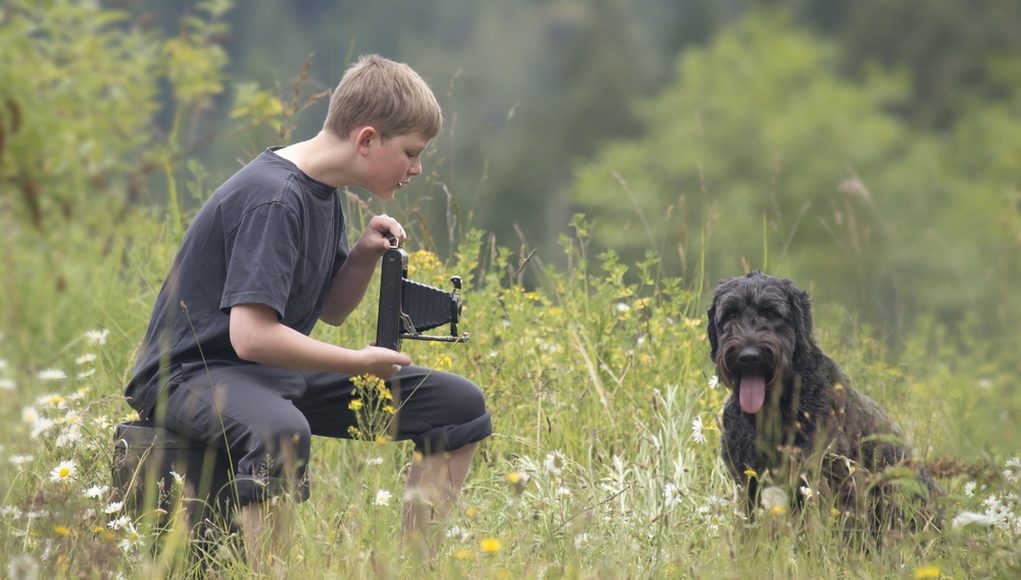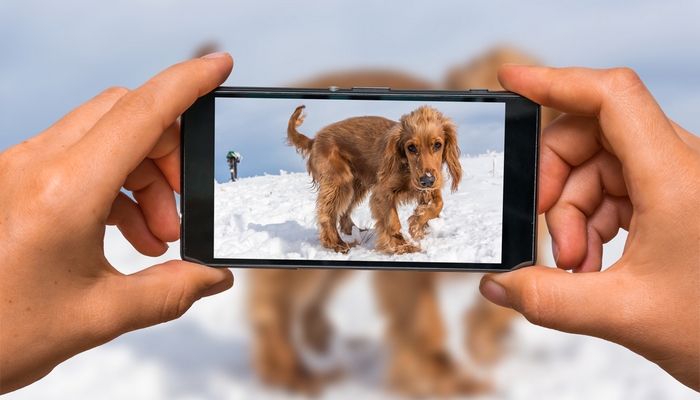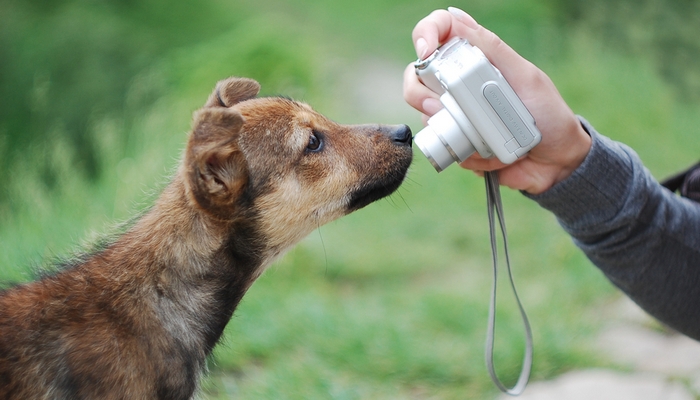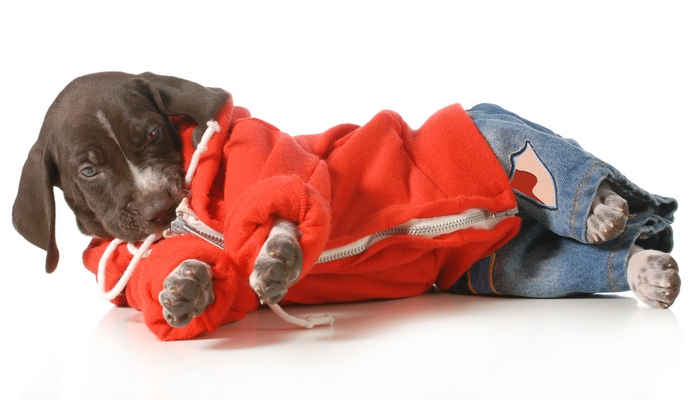For many people, pets are family. This means many families want to have great photos of their dog for their own personal album, to share on social media, or just to have with them if they're missing their pet. Unfortunately, dogs don't always pose neatly for pictures! These dog photography tips will help you to get some great photos of your furry friend.
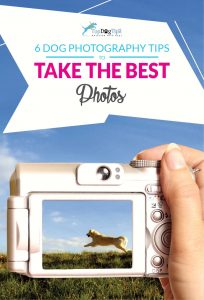 Most of us see adorable dog photos on social media or in a magazine, and we think that we can take similar photos of our pets. You gather your camera and a few props, but you quickly realize that your canine companion isn't on the same page. He won't sit still, he doesn't want to look at the camera and it's likely that he'll get bored after a 5 minute doggy photo shoot.
Most of us see adorable dog photos on social media or in a magazine, and we think that we can take similar photos of our pets. You gather your camera and a few props, but you quickly realize that your canine companion isn't on the same page. He won't sit still, he doesn't want to look at the camera and it's likely that he'll get bored after a 5 minute doggy photo shoot.
So how do owners get good pictures of their dogs? It takes time and patience. You need to remember that sitting and looking at a camera is unnatural for a dog. You sit and smile because you know that's what you need to do, but your pup doesn't understand that.
Your dog has other things on his mind. He needs time to get used to the environment, the props and the camera. Chances are, if you relax and have a little fun with your Fido you'll end up with much better pictures.
6 Dog Photography Tips: How to Take Great Photos of Your Dog
1. Get Your Dog Used to the Camera
Whether you use a DSLR camera or just your cell phone, you'll need to get your dog used to the camera to take the best pictures. If you just whip out your photography device before your dog knows what to expect, you may scare him and ruin the photo opportunity.
To avoid this, carry your camera around sometimes, even when you aren't taking pictures. Let your dog get used to seeing the device and give him some treats to associate the camera with positive experiences. This way, when the perfect moment strikes, you can take out your camera without worrying about frightening your dog – he'll already be used to it!
RELATED: 5 Must-Have Dog Photography Tools
2. Use Motivation
One of the best dog photography tips to get your pooch to hold still is to use some kind of motivation, like a treat or a toy. First, butter him up – give your dog a few small treats so he knows you have the treats in-hand and you're going to be giving them out. Think of it as similar to teaching your dog a new trick.
Once Fido knows you are serious about rewarding him, you can use the treat as motivation to hold still. Hold the treat in one hand up by the camera. Command your dog to stay, and hopefully he'll sit still and focus on that treat! Snap the picture while he is looking in the direction of the camera.
A toy will serve the same purpose if your pooch loves to play. Squeaky toys are best, as the noise will attract the dog's attention. Do the same thing here as you did with the treat – hold the toy up near the camera so your dog will look that way.
3. Lighting Options
While lighting is important for all photography, it's especially a big consideration for pets. One of the most important dog photography tips is that you need to remember that using the flash is off the table – not only is it a distraction for pets, it can also frighten him and send him running. An additional concern, as most people know, is the flash has the ability to give your dog a severe case of creepy red eye.
So what kind of lighting should you use instead?
Natural lighting is the best option when it comes to pet photography. If you can get your dog outside, this is likely the best option for highlighting him. This outdoor light is the easiest light source for beginners to work with, and it will also provide a great backdrop for your furry friend.
Remember, when shooting photos outdoors, avoid areas in direct sunlight -some shade is going to be best.
Indoor lighting can work too. The best option is catching your pet in a room with lots of windows and sunlight. Natural light is still the best option, even indoors. If this isn't an option, artificial light can work too. You may want to try a few angles with artificial lighting to see which one comes out best on your camera.
SIMILAR: How To Take Great Photos of Your Dog
4. Smile!
A lot of people want to catch their dog with that trademark ‘smile' – you know, tongue flopping out, big grin on their face. However, dogs typically don't do this on command! If you want to get your pup to have a big smile, take him out for a quick run in the backyard or at the park.
If he doesn't want to get going, try a nice game of fetch or tug-of-war. The physical activity will get him panting, which will produce that super cute dog smile. Once you get to this point, just shoot away!
5. Props and Outfits
While a natural picture of your dog is great, it can be fun to include some props or even outfits to get a unique photograph. One of the best dog photography tips is to add a simple splash of color from a toy, bed, or bandana. It can add a whole new dimension to your photo.
Once your dog is used to the camera, try adding in some additional items or scout out a new location for some variety. Before you try to dress your dog up or introduce him to a new toy, make sure he'll be comfortable with the addition. Not every dog is going to love getting put in a little shirt.
Some dogs are also fearful of certain toys, especially big ones or toys with loud squeakers. For best results, go with what you know your dogs likes. You'll get a candid shot, and you won't give him a reason to fear having his photo taken.
6. Try Different Angles
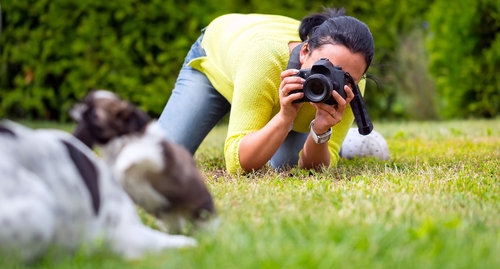 Don't feel like you always have to shoot your dog from the same front-facing direction. Catching your dog at different angles is a great way to get a unique photograph.
Don't feel like you always have to shoot your dog from the same front-facing direction. Catching your dog at different angles is a great way to get a unique photograph.
Try getting to some high ground to look down at your pet while he sleeps; this is a great way to catch him curled up and looking cute. Getting below your pet is a cool way to get a regal shot of him, especially with the right background.
Another fun idea is to vary what parts of your dog you shoot. Most people try to get their dog's whole body into a shot, but you can get a really cute picture by just focusing on his paws, tail, or face too! This will give you a unique picture that can capture a different part of your pet.
Remember, you don't have to be a professional in order to get high-quality photos of your dog. Using these dog photography tips, you can get some amazing pictures for a lifetime of memories you can share with family and friends.


